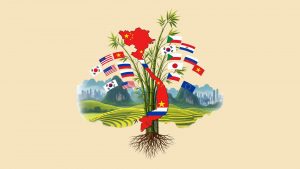Book Review: Peter Frankopan, The Earth Transformed: An Untold History (London, 2023)
Your blood is full of plastic. If you’re pregnant, then so is the body of your unborn child. There are scraps of the stuff at the summit of Mount Everest. Drinks bottles from East Asia frequently wash up in the Galapagos – if they are not caught by the Great Pacific Garbage Patch. Plastic is so ubiquitous that it literally defines our civilisation – and always will. If alien archaeologists ever visit Earth a few million years from now, the only trace we will have left in the geological record will be a narrow band of radioactive plastic.
It’s not just plastic, either. We’re all familiar with the roll-call of doom: massive spikes in greenhouse gas production, land and water poisoned by industrial runoff, cities rendered nearly uninhabitable by toxic smog, fish stocks decimated, oceans stripped of oxygen, forests cut down wholesale to graze cattle or grow palm oil. Every summer vies to be hotter than the last, while sea levels creep steadily up. In the UK alone, insect numbers have collapsed by 60% since just 2004 – and without insects there can be no food. The speed of change, and the sense that it is starting to run at a pace we can’t keep up with, really comes into view when you realise that half of all the carbon emissions in history have been made since the first episode of Friends aired.
Our pernicious impact on the planet is all the more remarkable when you consider that mankind has only been around for the briefest of flashes in geological time. If the history of the world since it was first spun out of cosmic debris 4.54 billion years ago were represented as a 24 hour clock, homo sapiens doesn’t even appear until 315,000 years ago – or 77 seconds to midnight. Most of those 77 seconds are filled up by grunting ape-men huddling in caves, hiding from apex predators and dying at 20. The first cities emerged just 5000 years ago, in what is now Iraq. China, having been around for more than 4000 years, is the world’s longest continuously running civilisation – but even this represents the barest fraction of human history. And for most of this time, we were very much at the mercy of the planet, not the other way round. But in just a century or two, we have changed the balance of power – and are reaping the consequences.
We all know this, of course. Beyond those bitter-enders determined to keep their heads in the sand, all of us are aware that human-led climate change is real. Those of us who look into it more closely can despair even more, when we begin to appreciate the true scale of the trade-offs needed to combat it. It might easily seem as if there is no way out. So, with our eyes nervously on the future, perhaps the time is right to reach back into the past for answers.
Humans are very much part of a broader biosphere, but even history buffs can often fail to appreciate this. We used to talk of history as a procession of kings, queens and great battles: Alexander marched to India, the First Emperor unified China, Sir Francis Drake circled the globe, Napoleon invaded Egypt. Were they alone? Of course not. Since the middle of the twentieth century, there has been a move towards new kinds of history, putting ordinary people back into the story, and appreciating the roles that technology, economics, and institutional dynamics all played. But the newest, most exciting frontier in history in undoubtedly environmental history. Although it has been around for a while – Alfred Crosby was popularising it fifty years ago – now, huge advances in computing power and scientific techniques unlocking areas previous outside the reach of professional historians, and casting radically different light on even the most familiar topics. But as Peter Frankopan, professor of global history at Oxford, convincingly argues in his recent book – soon out in paperback – we are, in the face of the climate crisis, not paying more attention than ever before to the role of climate in history. History, he says, is as much about natural events and how people respond to them, as it is about people themselves. It also has valuable lessons for today, as we face down another disaster.
Climate change, though now seemingly accelerating, is a constant companion to and driving force in human history. We have faced crisis before – even, hard as it might seem to imagine – on a greater scale than now. 70,000 years ago, the entire global population was reduced to about about a thousand breeding pairs – and maybe, according to one study, as few as forty – by the eruption of Toba, a supervolcano in what is now Indonesia. Toba dropped six centimetres of ash over all of India, Southeast Asia and Arabia, where it can still be seen in the geological record, filled the atmosphere with poisonous gas, and dimmed the sun for six years. Not only this, it also diverted rivers, poisoned lakes, and cooled the earth by several degrees. Animals and plants were wiped out wholesale, and early humans reduced to scrabbling for scraps in a blasted wasteland. This terrifying story is also oddly reassuring, in a strange way. If grunting pre-verbal cavemen could come back from such a catastrophe, surely modern humans, with all our technological might and intelligence, could have a crack at climate change? (Professor Frankopan, with a true historian’s awareness of mankind’s limitless capacity for blunders and screw-ups, is less sure).
Toba isn’t the end of it, either. Volcanoes are a recurring motif in The Earth Transformed, and Professor Frankopan is clearly itching to write a shorter article about their role in history. In one bold segment, he uses new studies of volcanic activity to look at one of the greatest, but most familiar, stories in western history: the fall of ancient Egypt and the rise of the Roman Empire, most commonly understood in the very humans terms of the three-way tragedy of Cleopatra, Julius Caesar and Mark Antony and the final triumph of Octavian, later Emperor Augustus. But what, Professor Frankopan asks, if all this is just set-dressing for the real story? What if Rome triumphed because of the eruption of Tokmak, a volcano in Alaska? It threw so much ash into the atmosphere, distributed in just the right way, that grain harvests failed in Egypt. This not only fatally weakened the last dynasty, but also drove up the price of bread in Rome, making the people restless and giving Caesar his opportunity to seize power. The chaos that resulted from his assassination prepared the ground for Augustus to re-establish control, promising a return to order – just as harvests were recovering from Tokmak.
Nor, of course, is it just volcanoes, though they punctuate the narrative with an unnerving regularity. (So as to not let any readers escape his point, Professor Frankopan spells it out for us: based on an analysis of volcanic cycles, we are seriously overdue for an eruption of the world-ending kind, like Toba). This chunky book is a steady drumbeat of flood, famine, plague and fire, effortlessly skipping across space and time, even if sometimes this can leave our heads spinning. The pace is relentless, as befits a book dealing with such a vast topic, and huge events can whip by before we really have a chance to get to grips to them. Like a journey on a bullet train, on reaching the end we are left with fragments, glimpses and half-formed impressions of all that’s rushed by outside. Oddly enough, reading The Earth Transformed reminded me of a very different book, Bill Bryson’s genial chunter through science, A Short History of Nearly Everything (2004), which managed to span the same wild variety of topics and an even broader time span with both of its feet firmly on the ground. Likewise, although Frankopan’s account of the general crisis of the seventeenth century – now widely accepted to a reflection of environmental catastrophe – is a solid survey, it left me hungry for the rich detail of Geoffrey Parker’s incomparable account, Global Crisis (2013), which was particularly strong on China and the blood-soaked collapse of the Ming Dynasty, an area Frankopan could have paid more attention to.
Frankopan’s book is full of thrilling revisionism, and he has done an immense service in digesting thousands of dense technical studies and a decade of reading into a rollicking narrative. Few can claim to have mastered the literature like Professor Frankopan, let alone have distilled their research into a such a cracking read. When following the notes (frustratingly relegated to a dedicated website, an increasingly common practice), we find that any given page can reference fifteen dense technical studies that represent years of work, each summarised into a pithy sentence or two. The amount of learning on display in The Earth Transformed is simply staggering, and while the sheer number of facts can sometimes threaten to overwhelm the narrative, there is probably no one else working in Anglophone academia today who can so confidently move from ancient Sumerian grain yields to classical Chinese hydraulic engineering via the carbon-dating of artefacts from medieval West Africa, and not lose his readers on the way.
While the first third of the book has a tendency to stumble – the dinosaurs come and go in less than a page – Professor Frankopan really hits his stride when on firmer ground, in recorded history. As mentioned above, the chapters on ancient Rome, its relationship with Parthia and Egypt, and its afterlife in Byzantium, are masterly. Those places and people that came to thrill us in The Silk Roads nearly a decade ago make a welcome reappearance here, and by the time we’ve reached the early modern period and the ‘rise’ of Europe, the pages fly by in their hundreds. Those familiar with The Silk Roads will know that Frankopan is no stranger to the bravura performance, and The Earth Transformed doesn’t disappoint. To singlehandedly upend popular conceptions of world history once is remarkable; to do it twice in a decade is nothing short of extraordinary. In typical style, The Earth Transformed delivers on its ambitious themes – although a pedant would argue that environmental history is hardly ‘an untold story’, as the subtitle claims.
Professor Frankopan has shown brilliantly how all history is environmental history. As we hurtle head-first into one of the greatest environmental crises in history – on par with those that did for the dinosaurs and almost wiped out early humans – we will do well to bear his work in mind. Everyone from Berkeley to Beijing should read this book if they can, and look to its lessons for a dose of perspective, and a necessary jolt of fear. It’s worth remembering that 24 hour clock. Even the dinosaurs only roamed the earth for the equivalent of 30 minutes.
- Sean Patersonhttps://asiascot.com/author/sean-paterson
- Sean Patersonhttps://asiascot.com/author/sean-paterson
- Sean Patersonhttps://asiascot.com/author/sean-paterson
- Sean Patersonhttps://asiascot.com/author/sean-paterson







